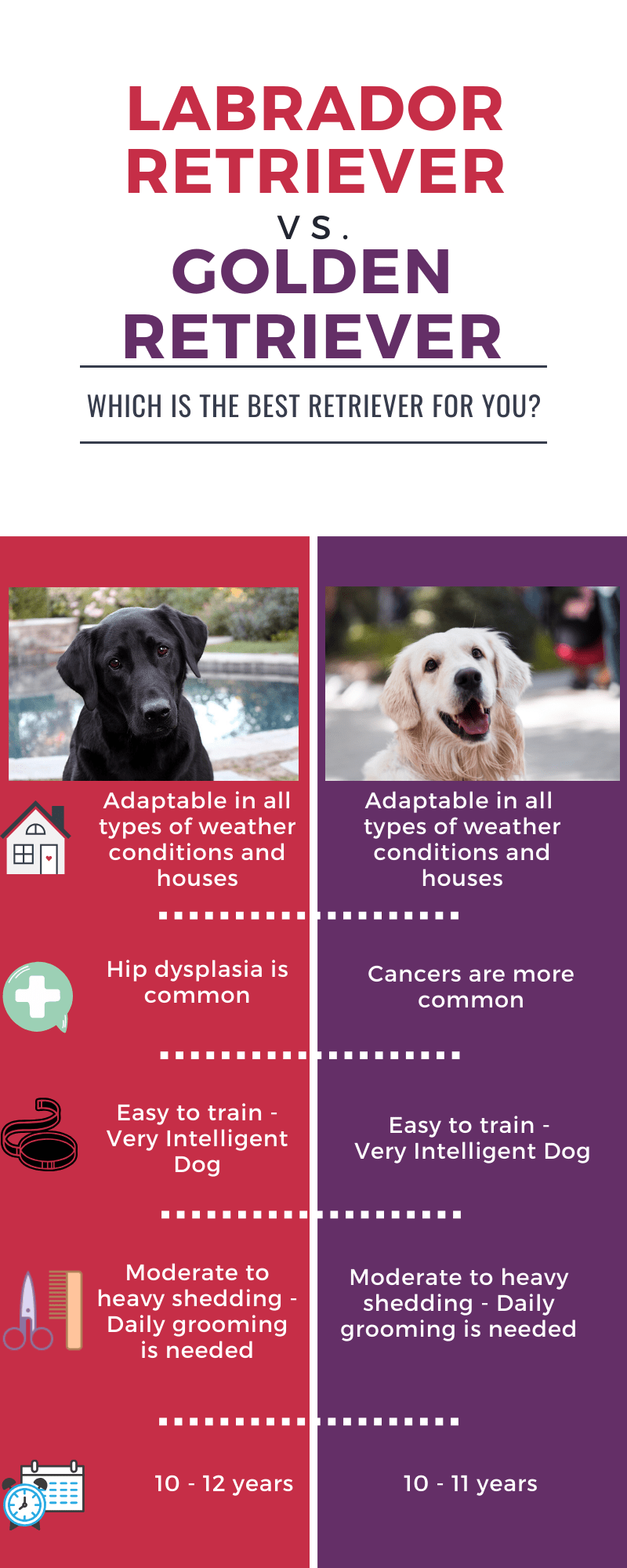Both the breeds are adorable, affectionate, energetic, and full of love. I’ve had three dogs in my life, a Pomeranian, German Shepherd, and a Labrador. The Pom and GSD crossed the rainbow bridge at the age of 14 and 12, respectively. The Labrador Retriever is one year old, is goofy, snuggling bug, and full of life.
At the end of this guide, you should be able to select the ideal dog that fits into your family. Let us know a brief history of these two dog breeds.

Origin and History
The Labrador retriever or the Lab has its origin dated back to the year 1830. Newfoundland dog was bred with the earlier retrievers to have a dog that loves to swim and has excellent stamina. Their primary motto is to retrieve the kill from the land and the sea.
They couldn’t name these dogs as Newfoundland because the name is already taken. Hence they called them Labrador because they worked close to the Labrador sea.
It became a famous dog throughout England by the late 1860s, and the AKC registered the first Lab in the year 1917. The Lab is the world’s first dog to appear on the cover page of a magazine. The December 1938 issue of the Life Magazine featured a black Lab on its cover page.
Golden retrievers were bred for a similar purpose; retrieving the kill. It is said that a Golden retriever can carry a raw egg in its mouth in their mouth without breaking the shell.
The Dudley Coutts Marjoribanks, 1st Baron Tweedmouth, or the Laird of Guisachan and Glenaffric developed the first Golden Retrievers by breeding the spaniels with the existing retrievers. He conducted several breeding experiments for about 50 years (1840 – 1890). The first Golden produced through this method was a female known as Tweed Water Spaniel.
The Tweed Water Spaniel is extinct, but the lineage of this dog and controlled inbreeding with other working dogs resulted in the present-day Golden. The AKC first registered it in the year 1925.
Physical Appearance
Both the Lab and the Golden are medium-large breeds. The Labrador Retriever is slightly larger than the Golden Retriever, but the difference isn’t very less to recognize.
The striking features of a Lab are floppy years, otter-like tail, and a water repellent coat. They have webbed paws which assist them in swimming. The thick tail is another tool for swimming, to change the direction.
The head of the Lab is broad and has strong, powerful jaws. You will be struck with awe with their kind and gentle eyes. No one can resist those lovely eyes. Their ears hang above the eye-line, and the tips are approximated towards the head.
A male Lab measures around 22 inches in height (56 cm) and weighs 65 – 80 lbs (29.5 – 36 Kgs). The female measures 24 inches (54 cm) with a weight of 55 – 70 lbs (25 – 31 kgs). The Labrador’s color has three distinct variations: black (most popular), yellow, and chocolate. It is misunderstood that a black Lab can have a litter of black or chocolate has chocolate. But the color of the litter does not depend on the color of their parents. A black lab can have all the three colors in its litter.
The double coat of the Lab is waterproof, short, and dense. It helps the dogs in staying warm in all weather conditions. Don’t worry; your Lab will not catch a cold in winter even if you take him to a swim.
The Golden Retriever’s characteristic feature is its coat and its color. It is golden in color and is either light gold or dark gold. There are no other color variations. The head is broad as the Lab but not so powerful jaws.
Golden Retrievers are known for their gentle mouths. Their floppy ears are more extended than Labs and do not approximate towards the nose. Being a retriever, they have webbed paws which assist them for efficient swimming.
Male golden retrievers measure about 22 – 24 inches (56 – 61 cm) in height and weigh 65 – 75 lbs (29 – 34 kgs). Females measure 20 – 22.5 inches (51 to 57 cm) in height and weigh 60 – 70 lbs (27 – 32 kgs).
There are few regional variations in their height and weight. Three distinct regional Golden retrievers are identified:
- American
- British
- Canadian
The Canadian Golden Retriever is a bit taller and heavier, whereas the American has a darker coat than the rest. These subtypes are due to their wide popularity and Pedigree Breeding.
Behavior and Temperament
There is a wide range of similarities between these two breeds. Both are very affectionate towards their family, friendly with everyone, and full of energy. If you consider the energy factor, the Lab has it a bit more than the Golden.
The Golden Retrievers are calm and friendly. These two characteristics are considered as hallmark features of the Golden, whereas the Labs are goofy and always ready to plunge on you with love.
Labradors have an innate character of 'fear no one’ that can cause problems if not addressed. They tend to inspect everything, and their over-enthusiasm fails them to differentiate friend from foe.
The Labs are quite intelligent and can be easily trained. While their affectionate nature does not require intense socialization, it must be noted that no two dogs are the same. An aggressive Labrador is due to a poor upbringing by their owner.
Labradors have a great sense of smell, which is because of this ability; they are widely used in bomb squads. They are not territorial but chase anything that runs. They do bark occasionally but are not intense.
Since the Labs are high on energy, sufficient space must be there for running or playing. Even though they are suitable for apartments, it is recommended to exercise them daily. Do not leave them unattended around children.
The Golden Retrievers are intelligent dogs than the Labradors. They are easily trainable, and they learn the commands in the first or second try. Their innate nature to please their owners makes them one of the best pets for all families. But note that, to please you, they will keep on working up to the brink of their collapse. Make sure you don’t make them overwork.
They are gentle and very patient with any given task, which makes them excellent baby sitters. I may be exaggerating, but it is ok to leave a Golden Retriever around kids unattended. But note that no two dogs are the same. If you are confident enough, you can.
Their affectionate and lovely nature does not need extensive socialization, but it is advised to do as much as you can.
Golden Retrievers are fun-loving and are always ready to play. Since they are calm dogs, they adapt to an apartment better than the Labrador. But it does not mean that they need minimal exercise. Being a medium-large dog breed, they need moderate to moderately high amounts of activity every day.
The Labrador Retriever and the Golden Retriever being affectionate with strangers (generally) make them poor guard dogs. Both are agile and are known to participate in agility competitions. The world record for the long jump into the water is by a black Labrador who plunged to a distance of 27 meters.
The willingness to learn of these two breeds will make them excellent companions for every family. Both breeds do well with other dogs if you have any.
It is quite hard to select the best dog between Labrador retriever vs Golden retriever in terms of temperament. The battle is neck to neck in terms of their behavior, and it’s a tie.
Grooming
The Golden Retriever has longer hair than the Labrador. It doesn’t mean that the Lab sheds less than Golden. Many pet owners who had both dogs, admitted that Lab sheds more than the Golden. Although it is a subjective statement, note that both dogs shed heavily.
They will shed twice a year heavily or slowly every day throughout the year. You will find hair strands in every corner of the house no matter which breed you own. For people who dislike hair strands on their clothes, sofas, or beds, both the breeds are not suggestible.
Daily grooming is a must. You can trim tiny bits of hair for the Golden Retrievers to minimize the grooming exhaustion.
Exercise/Physical Needs
Since both are medium-large breed dogs, it is advised to have sufficient space for the dog to run or play. Although they can adapt to an apartment environment, daily exercise is a must.
You must walk them for at least an hour a day. Make sure you walk them at night. If you are a first-timer, it would be a bit stressful to handle a Labrador puppy.
Labrador puppies are known for their intense teething habit, and it will last for more than a year. You can’t share your bed with them at night because of this reason. They tend to chew your arms, legs, and whatever they find attractive. You may end up with lots of bruises and cuts.
Even though I had prior experience with other dogs, raising my Labrador puppy was a lot stressful. You need to tire them out, especially at night. Take them for longer walks, make them run, or play as much as you can. They will sleep throughout the night. If you are not sharing the bed with the puppy or leave him in a crate or other room and, they will cry and whine a lot. You may suffer sleepless nights, and it adds a bit more stress on you.
But if you are patient and make them understand your daily routine, even a pup will learn your schedule in less than a month or two. My puppy learned our time table in just three weeks. All you need is dedication and patience. I will admit that there will be a few days where you may think 'why I got this dog?’. You’ve watched the movie Marley & Me, right? Yes! It can be very frustrating. It will be more if you are the first-timer and have toddlers or younger kids at home.
Labradors can be very jumpy with you as well as strangers. They tend to show their love by bouncing all over your body.
On the other hand, the Golden pups may not be this problematic. Because of their inherent calm nature and their willingness to please the owner, it might help you to raise the dog without any difficulties. It is advised that not bring the puppy home until they are eight weeks or older.
Life span and Health
The average lifespan of a Labrador Retriever is 12 years, whereas the Golden’s is 11 – 12 years. Both dogs have some common health problems such as:
- Cancer
- Hip-Dysplasia
- Eye problems such as Glaucoma
- Allergies
- Joint problems
The joint problems and hip-dysplasia are more common in Labrador, whereas cancers are more common in Golden Retrievers. Female dogs in both breeds are prone to a higher percentage of cancers if they are neutered.
Summary
Which is the Best Dog for You?
If you ask me to choose between Labrador retriever vs Golden Retriever, I will take both of them. Both dogs will lift your spirits irrespective of your situation. They are loaded with infinite amounts of love, and they will never run out of it.
But if you are a first-timer, it is ideal for getting a Golden Retriever than the Labrador. It is because of the high energy of the Labradors, and they are the mouthiest as pups. Labradors are sprinters; you must provide adequate space for him to run. If you have space and experience, you wouldn’t be reading this guide in the first place.
Even though you are a first-time pet owner and are willing to get a Labrador, go for it. All you need is a bit extra dedication and patience. Since they are intelligent dogs, you need not a world-class trainer or a professional to train them. They will obey your commands if you just know how to teach.
The conclusion for the battle of Labrador Retriever vs Golden Retriever is not that easy. If you are confident about yourself and the breeder, I am sure you will select a proper dog that fits your family well.
Have you decided? Let us know. We would love to hear from you.
References:
Association between coat colour and the behaviour of Australian Labrador retrievers by Diane van Rooy & Claire M. Wade
A Review of the Impact of Neuter Status on Expression of Inherited Conditions in Dogs by Anita M. Oberbauer, Janelle M. Belanger, and Thomas R. Famula
A Genetic Predictive Model for Canine Hip Dysplasia: Integration of Genome Wide Association Study (GWAS) and Candidate Gene Approaches by Nerea Bartolomé ,Sergi Segarra, Marta Artieda, Olga Francino, Elisenda Sánchez, Magdalena Szczypiorska, Joaquim Casellas, Diego Tejedor, Joaquín Cerdeira, Antonio Martínez, Alfonso Velasco,Arm and Sánchez

Lydia King is a huge animal lover and has always been fascinated with learning about the animal kingdom. She enjoys writing about anything animal related from scientific information about rare species to animal references in pop culture.














